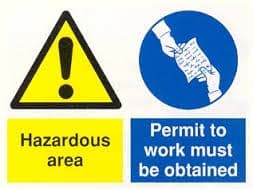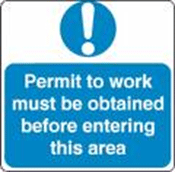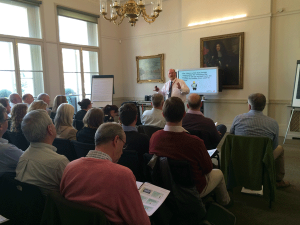This week we are looking at Permits to Work.
Last week I was asked about Permits to Work, when you need them, who issues them etc.
So this week I thought I would cover Permits to Work again as I haven’t discussed this topic for a year or so. Also an HSE survey showed that a third of all accidents in industry were maintenance-related, the largest single cause being a lack of, or deficiency in, permit-to-work systems!
We also have 2 recent HSE cases for you to look at and think about:
- “I am heartbroken and angry that Ben could go to work and be killed because his employer took so little care of him, failed to train him or make sure the workplace was safe.”
- The company has been fined £1million and ordered to pay costs of £30,000.
We hope you learn from the mistakes of others that are highlighted in our weekly newsletters and, as a result, do not have similar accidents at your workplace.
As ever, if you have a subject that you would like us to cover one week, please contact us by phone 01458 253682, email or via our Facebook page or by Twitter.
Permits to work
What are permits to work?
A permit-to-work system is a formal written system used to control certain types of work that are potentially hazardous. A permit-to-work is a document which specifies the work to be done and the precautions to be taken. Permits-to-work form an essential part of safe systems of work for many maintenance activities. They allow work to start only after safe procedures have been defined and they provide a clear record that all foreseeable hazards have been considered.
A permit is needed when maintenance work can only be carried out if normal safeguards are dropped or when new hazards are introduced by the work. Examples are entry into confined spaces, hot work, electrical works and asbestos removal.
What is the problem?
An HSE survey showed that a third of all accidents in industry were maintenance-related, the largest single cause being a lack of, or deficiency in, permit-to-work systems. In a study of small and medium-sized factories:
- two-thirds of companies were not checking systems adequately;
- two-thirds of permits did not adequately identify potential hazards;
- nearly half dealt poorly with isolation of plant, electrical equipment, etc.;
- a third of permits were unclear on what personal protective clothing was needed;
- a quarter of permits did not deal adequately with formal hand-back of plant once maintenance work had finished;
- In many cases little thought had been given to permit form design.
Of course, permits to work are not just required in factories. The guidance provided may have application in all types of work situations from building sites, hospital plant rooms, schools and even offices
What do you need to do?
Don’t assume that your system is a good one just because you have not yet had a serious accident. You should critically review your system and ask yourself the following questions.
Information
- Is the permit-to-work system fully documented, laying down:
- How the system works;
- The jobs it is to be used for;
- The responsibilities and training of those involved; and
- How to check its operation?
- Is there clear identification of who may authorise particular jobs (and any limits to their authority)?
- Is there clear identification of who is responsible for specifying the necessary precautions (e.g. isolation, emergency arrangements, etc.)?
- Is the permit form clearly laid out?
- Does it avoid statements or questions which could be ambiguous or misleading?
- Is it designed to allow for use in unusual circumstances?
- Does it cover contractors?
Selection and training
- Are those who issue permits sufficiently knowledgeable concerning the hazards and precautions associated with the plant and proposed work? Do they have the imagination and experience to ask enough ‘what if’ questions to enable them to identify all potential hazards?
- Do staff and contractors fully understand the importance of the permit-to-work system and are they trained in its use?
Description of the work
- Does the permit clearly identify the work to be done and the associated hazards?
- Can plans and diagrams be used to assist in the description of the work to be done, its location and limitations?
- Is the plant adequately identified, e.g. by discrete number or tag to assist issuers and users in correctly taking out and following permits?
- Is a detailed work method statement given for more complicated tasks?
Hazards and precautions
- Does the system require the removal of hazards and, where this is not reasonably practicable, effective control
- Are the requirements of The Control of Substances Hazardous to Health Regulations 1999 (COSHH) and other relevant legislation known and followed by those who issue the permits?
- Does the permit state the precautions that have been taken and those that are needed while work is in progress? For instance, are isolations specified and is it clear what personal protective equipment should be used?
- Do the precautions cover residual hazards and those that might be introduced by the work, e.g. welding fume and vapour from cleaning solvents?
- Do the Confined Spaces Regulations 1997 apply? If so, has a full risk assessment identified the significant risks and identified alternative methods of working or necessary precautions?
Procedures
- Does the permit contain clear rules about how the job should be controlled or abandoned in the case of an emergency?
- Does the permit have a hand-back procedure incorporating statements that the maintenance work has finished and that the plant has been returned to production staff in a safe state?
- Are time limitations included and is shift changeover dealt with?
- Are there clear procedures to be followed if work has to be suspended for any reason?
- Is there a system of cross-referencing when two or more jobs subject to permits may affect each other?
- Is the permit displayed at the job?
- Are jobs checked regularly to make sure that the relevant permit-to-work system is still relevant and working properly?
Essentials of the Permit to Work form 
The permit-to-work form must help communication between everyone involved. It should be designed by the company issuing the permit, taking into account individual site conditions and requirements.
Separate permit forms may be required for different tasks, such as hot work and entry into confined spaces, so that sufficient emphasis can be given to the particular hazards present and precautions required.
The essential elements of a permit-to-work form are listed below. If your permit does not cover these it is unlikely to be fully achieving its purpose.
- Permit title
- Permit Number
- Job location
- Description of the work to be done. With its limitations
- Plant identification
- Hazard identification – including residual hazards and hazards introduced by the work
- Precautions necessary – person(s) who carries out precautions, e.g. isolations, should sign that precautions have been taken
- Protective equipment
- Authorisation – signature confirming that isolations have been made and precautions taken, except where these can only be taken during the work. Date and time duration of permit
- Extension/shift handover procedures – signatures confirming checks made that plant remains safe to be worked upon, and new acceptor/workers made fully aware of hazards/precautions. New time expiry given
- Acceptance by operatives. With legible signatures and names
- Hand-back. Signed by the acceptor certifying the work completed and by the issuer certifying work is completed and plant ready for testing and re-commissioning.
- Cancellation. Certifying work completed and plant tested and re-commissioned.
PERMITS SAVE LIVES – GIVE THEM PROPER ATTENTION
Signatures and names must be legible.
If you need further information please call us on 01458 253682 or send us an email.
Taunton & Somerset CPD Group at The Lawns Taunton
Trust you are all having a good summer despite the weather and we hope you will all be able to attend the next CPD Group meeting as it looks like it will be very interesting.
Martin Kent our Customer Relations Manager has arranged this month’s seminar – see below. As previously requested, if you could let Martin know whether or not you can attend it would be greatly appreciated. Also, if you would like to give a talk, or know of somebody who would, please contact Martin.
The first of these Autumn seminars is on Wed 13th September at 12:15pm prompt please: at The Lawns Taunton.
Our Speaker will be from Altro Flooring will be coming along to do a “Designing for Dementia”.
If you haven’t already booked your place, or if you are not on the CPD Seminar mailing list but would like to be please drop Martin an email and he will deal with your request.
Just to give you some advanced notice the next seminar will be 18th October when GronoDec will be coming along.
Then the final Seminar of the year will be 22nd Nov speaker to be confirmed.
Training
We have several courses running soon:
- CDM Regulations 2015 – An Awareness Course – 18th September 2017
- CDM Regulations 2015 – For the Smaller Builder – 27th September 2017
- ASBESTOS AWARENESS – 27th September 2017
- CDM Regulations 2015 – Principal Designer Course – 12th & 13th October 2017
- BSC Level 1 Award Health and Safety in a Construction Environment – 16th October 2017
- Supervising Staff Safely – 24th & 25th October 2017
